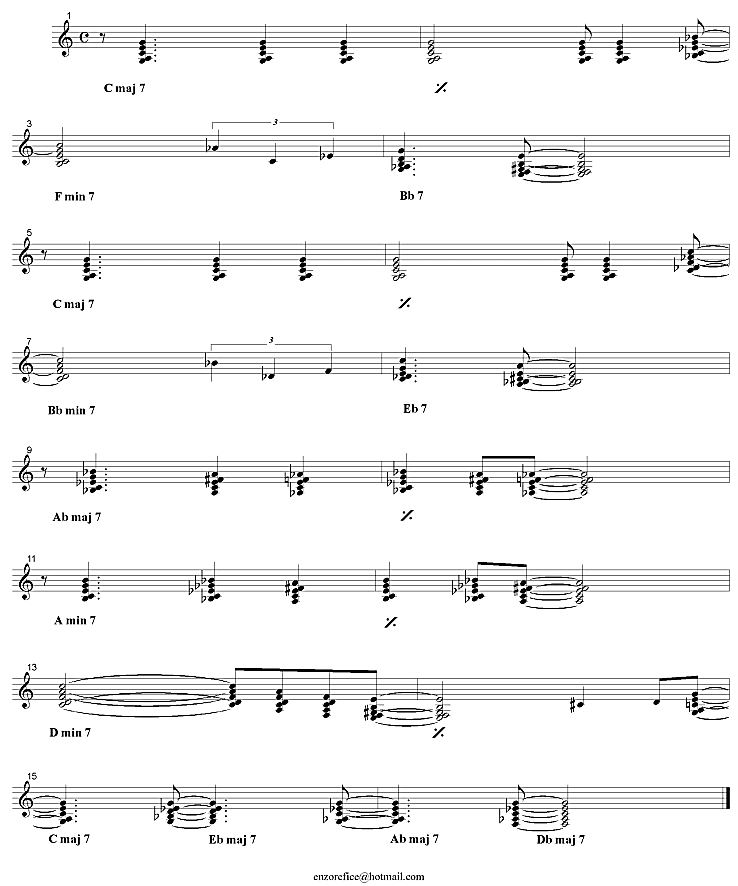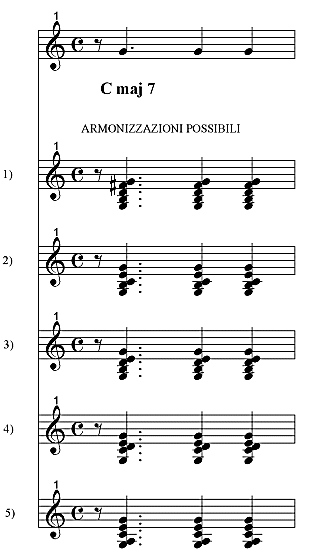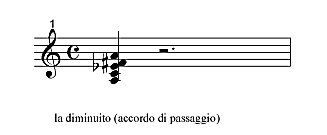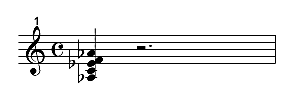|
Fai click qui
per leggere la versione italiana
 Hi
friends, as you have perceived by invitation from the title, in this lesson I'll
speak about the harmonization in five parts, of course, imagining a
percussion and a double-bass that accompany our sax's section (a big band sax's
section). Hi
friends, as you have perceived by invitation from the title, in this lesson I'll
speak about the harmonization in five parts, of course, imagining a
percussion and a double-bass that accompany our sax's section (a big band sax's
section).
I would like to specify that unfortunately not all melodies are suitable
to this treatment, in fact probably many arrangements techniques were born
because of the need to find resolution suitable to that melody, to those
harmonies and to the structure. By the way going back to our harmonization, to
test I've chosen, it's a very famous standard of
Tadd Dameron: Lady Bird ( ). ).
We'll realize in a clear and simple way this theme's harmonization
imagining first of all to have our 5 sax (2 contralto, 2 tenors, 1 baritone):
- the first voice (the
singing) we deviously be unvaried and given to the first contralto
- the second we'll be third
descendent distance from first, the third at third descendent
distance from the second, and the fourth at third descendent
distance from the third. Of course thirds voice be majors and minors
depending on the chord they belong to.
The harmonization's principal aim is to keep the parts at a third distance
between then except for the baritone that instead voice always be at
octave with the melody for three good reasons:
- to give more strength and
compactness to the block
- to further on mark the
test's melody
- to give tension, because
in the different cases, as we'll see in the examples, it will be or at
second major distance or at semitone distance from the fourth voice (second
tenor), causing so an effective and beautiful tension.
MUSICAL EX. n. 1 (5 parts harmonization on just one score)

The ritmic side in this harmonization I've faithfully slicked
with the original score except in the final part where I've given a light ritmic
movement to "G" tied semi minimum, further or marked accent from the four
final test's chords. It's very important to see how the tension take place,
especially in the harmonization's first part, between the fourth (second tenor)
and fifth (baritone) voice.
N.B.:
in cases of measures n° 3 and n° 7, where you can clearly
read one voice the sax will be distributed following this scheme:
|
first high, second high,
first tenor |
written voice |
|
second tenor and baritone |
under octave |
Let's analyze in a more accurate way how is the procedure of each melody's
note of this harmonization and let's pause or:
MUSICAL EXAMPLE N° 2 (5 different harmonization for our theme)

I won't singularly analyze each note's harmonization of the theme,
because the harmonization is always the same, I will only explain the exceptions
to our small rule of harmonizing a theme.
Clearly reading the examples we can notice that all the voices are
included in an octave, and depends on the case, we always have two voices at
semitone or tone's distance, then we can observe that:
-
in example n° 2.1 the tension (F# - G) is between the first and
second voice, apart to be not very effective, it's also quite unpleasant for our
ears or better it's out of tune. It's always advisable to avoid discords and
tensions between the first two voices, especially if the first one belong to a
melodic and thematic line.
-
in example n° 2.2 the tension (B – C) is between the second and
the third voice, this harmonization isn't too bad but definitely works better
with weak tunes, passing notes and so on.
-
in example n° 2.3 the tension (D – E) is between the first and
second voice but unlike to example n° 1 is better, the first in fact is a third
distance from the most near voice and you can't hear outs of tune.
-
in example n° 2.4 the tension (C – D – E) is double, in fact we
have the second, the third, and fourth, all with tone distance between then.
This resolution isn't very effective in the thematic stage, but could be used as
an effect.
-
in example n° 2.5 the tension (G – A) is between the third and
fourth voice. This is without a doubt the best because first of all the other
four voices are at third distance (see general rule) and then when the tension
is low (in the chord's general voicing) everything sound extremely clear. This
part harmonization is the one I have mostly used for the melody of this test.
Carry on analyzing the test harmonization we can notice that: (b. 9 –
second chord; b. 11 third chord) the thirds aren't anymore organized
according to our scheme. We in fact find first a diminished chord. This
chord (naturally arranged in minor thirds) is already perfect in this own
MUSICAL EX. n. 3 (diminished chord)

The procedure of this harmonization is melodically needed. If we found it
on strong times it would have been very pleasant but on weak time (where we find
it) it works well.
Then we have a harmonization in which the discord is between the first
and second voice (b. 9 – third chord ; b. 10 – third chord)
MUSICAL EX. n. 4

This harmonization exists because of the melody's harmonic need. On
strong time it wouldn't have been very pleasant but on a weak time (where we
find it) works very well.
Many of you are asking yourself why on harmony Amin7 (b. 12
– third chord) we have an harmonization with decreased chord?
In reality this is possible because the harmonic function of that chord
is D7 (that naturally doesn't module but becomes second of C
tonality), consequently works well.
Another small exception we find at (b. 13) in fact happens at the
first voicing of Dmin7 is just a drop (a drop is like a revolt
in classical music and means putting on octave down or up, the voice more
high maintaining the same voicing's notes).
Finally another small exceptions are the final chords where the discord
is before between the second and the third voice (b. 15 – second chord),
then between the third and fourth voice (b. 15 – third chord). This
happens for a simple willingness to want to use an harmonic link between these
chords. In fact as it's noticeable the parts move very little.
The past chord instead (b. 16 – second chord) is a Dbmaj7
completed putted in third order, only missing of the fundamental (which the
double bass will take care of) this to have a last clear chord very definite and
rich.
Well, I hope I've been quite clear and exhaustive, I hope you work well on
your harmonization…..and see you in the next lesson!!!
Insert a comment
©
2000 - 2001 Jazzitalia.net - Enzo Orefice - All rigths reserved
|
© 2000 - 2026 All the material published on Jazzitalia is exclusively owned by the author. Moreover it is protected by International Copyright, so it is forbidden any use of it which isn't authorised by the rights' owner.
|
This page has 6.643 hits
Last Modified Date: 17/04/2006

|
|

